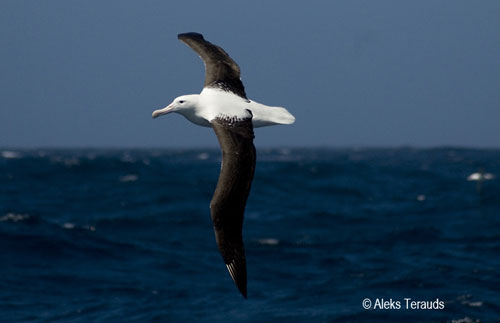BirdLife International manages a Globally Threatened Forum for Seabirds which considers which threatened species should be recategorized.
Discussions on the status of the ACAP-listed Northern Royal Albatross Diomedea sanfordi and Black-footed Albatross Phoebastria nigripes were undertaken by the Forum in 2011, but both species have had their reassessments pended as there was insufficient information available by this year's deadline. Discussions remain open for input and these species will now be assessed as part of the next comprehensive re-evaluation of all species, due for release in May 2012.
The Northern Royal Albatross Diomedea sanfordi is currently listed as Endangered by IUCN on the basis that the species occupies an Area of Occupancy of less than 10 km², including fewer than five locations (three island groups), in which the population is estimated to be undergoing a very rapid decline.
The rate of decline is estimated at 50-79% over 84 years (1985-2069; estimate of three generations), and is caused primarily by the destruction of most vegetation and removal of soil cover on the Chatham Islands (where 99% of the global breeding population breeds) when a cyclonic storm hit them in 1985. Birds subsequently constructed their nests with stones, or laid eggs on bare rock. As a result, mean annual productivity plummeted to 8% (1990-1996) on the Forty-Fours, and 18% over all three islands, due to egg breakage, exposure to high temperatures and flooding, although there has since been a partial recovery.
By 2007, annual herb-field vegetation cover had recovered to about 70% of that recorded in the 1970s. The soil base is still minimal, but improving. Although productivity has continued to improve, the mean annual chick production during 1995-2003 was still only 66% of the mean annual productivity in the 1970s. It is estimated that for the 20-year period 1985-2005 there was a total 50-60% reduction in productivity for the species. However, it is clear from the annual chick production figures that the annual breeding population is becoming much more balanced than in the 1990s, when as much at 80-90% of the breeding population was attempting to breed annually (rather than the normal 60%).
In 2002, a survey at the end of egg-laying recorded 5800 pairs, with a probable 1700 pairs on sabbatical (after breeding in the previous season). This suggests that in spite of the extensive reduction in productivity over a 20 year period, the number of breeding pairs may have remained relatively stable.
The effects of severe weather and projected climate change are regarded as serious potential threats; however the ongoing threats of fisheries bycatch, the direct harvesting of chicks and the effects of introduced species are regarded as minor. Further information on this species' current and projected population trends over a period of 81 years (revised estimate of three generations), as well as the estimated population size, is requested to help in the assessment of its threat status.
Selected references:
Robertson, C.J.R. 1998. Factors influencing the breeding performance of the Northern Royal Albatross. In: Robertson, G. & Gales, R. (Eds). Albatross Biology and Conservation. Chipping Norton: Surrey Beatty & Sons. pp. 99-104.
Robertson, C.J.R.., Bell, E.A., Sinclair, N. & Bell, B.D. 2003. Distribution of Seabirds from New Zealand that Overlap with Fisheries Worldwide. Science for Conservation 233. Wellington: Department of Conservation. 23 pp.
Taylor, G.A. 2000. Action Plan for Seabird Conservation in New Zealand. Part A: Threatened Seabirds. Threatened Species Occasional Publication 16. Wellington: Department of Conservation. 236 pp.
Information taken from the Globally Threatened Forum for Seabirds (click here) with thanks.
John Cooper, ACAP Information Officer, 27 July 2011

 Français
Français  English
English  Español
Español 